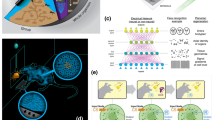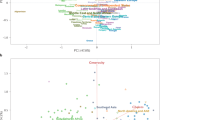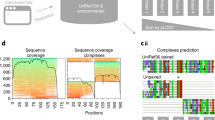Abstract
In physical, biological, technological and social systems, interactions between units give rise to intricate networks. These—typically non-trivial—structures, in turn, critically affect the dynamics and properties of the system. The focus of most current research on complex networks is, still, on global network properties. A caveat of this approach is that the relevance of global properties hinges on the premise that networks are homogeneous, whereas most real-world networks have a markedly modular structure. Here, we report that networks with different functions, including the Internet, metabolic, air transportation and protein interaction networks, have distinct patterns of connections among nodes with different roles, and that, as a consequence, complex networks can be classified into two distinct functional classes on the basis of their link type frequency. Importantly, we demonstrate that these structural features cannot be captured by means of often studied global properties.
This is a preview of subscription content, access via your institution
Access options
Subscribe to this journal
Receive 12 print issues and online access
$209.00 per year
only $17.42 per issue
Buy this article
- Purchase on Springer Link
- Instant access to full article PDF
Prices may be subject to local taxes which are calculated during checkout



Similar content being viewed by others
References
Newman, M. E. J. The structure and function of complex networks. SIAM Rev. 45, 167–256 (2003).
Amaral, L. A. N. & Ottino, J. Complex networks: Augmenting the framework for the study of complex systems. Eur. Phys. J. B 38, 147–162 (2004).
Watts, D. J. & Strogatz, S. H. Collective dynamics of ‘small-world’ networks. Nature 393, 440–442 (1998).
Newman, M. E. J. Assortative mixing in networks. Phys. Rev. Lett. 89, 208701 (2002).
Pastor-Satorras, R., Vázquez, A. & Vespignani, A. Dynamical and correlation properties of the Internet. Phys. Rev. Lett. 87, 258701 (2001).
Colizza, V., Flammini, A., Serrano, M. A. & Vespignani, A. Detecting rich-club ordering in complex networks. Nature Phys. 2, 110–115 (2006).
Barabási, A.-L. & Albert, R. Emergence of scaling in random networks. Science 286, 509–512 (1999).
Amaral, L. A. N., Scala, A., Barthélémy, M. & Stanley, H. E. Classes of small-world networks. Proc. Natl Acad. Sci. USA 97, 11149–11152 (2000).
Girvan, M. & Newman, M. E. J. Community structure in social and biological networks. Proc. Natl Acad. Sci. USA 99, 7821–7826 (2002).
Newman, M. E. J. & Girvan, M. Finding and evaluating community structure in networks. Phys. Rev. E 69, 026113 (2004).
Guimerà, R. & Amaral, L. A. N. Functional cartography of complex metabolic networks. Nature 433, 895–900 (2005).
Guimerà, R. & Amaral, L. A. N. Cartography of complex networks: modules and universal roles. J. Stat. Mech. Theor. Exp. P02001 (2005).
Guimerà, R., Mossa, S., Turtschi, A. & Amaral, L. A. N. The worldwide air transportation network: Anomalous centrality, community structure, and cities’ global roles. Proc. Natl Acad. Sci. USA 102, 7794–7799 (2005).
Danon, L., Díaz-Guilera, A., Duch, J. & Arenas, A. Comparing community structure identification. J. Stat. Mech. Theor. Exp. P09008 (2005).
Jeong, H., Tombor, B., Albert, R., Oltvai, Z. N. & Barabási, A.-L. The large-scale organization of metabolic networks. Nature 407, 651–654 (2000).
Wagner, A. & Fell, D. A. The small world inside large metabolic networks. Proc. R. Soc. B 268, 1803–1810 (2001).
Uetz, P. et al. A comprehensive analysis of protein–protein interactions in Saccharomyces cerevisiae. Nature 403, 623–627 (2000).
Jeong, H., Mason, S. P., Barabási, A.-L. & Oltvai, Z. N. Lethality and centrality in protein networks. Nature 411, 41–42 (2001).
Maslov, S. & Sneppen, K. Specificity and stability in topology of protein networks. Science 296, 910–913 (2002).
Li, S. et al. A map of the interactome network of the metazoan C. elegans. Science 303, 540–543 (2004).
Barrat, A., Barthélemy, M., Pastor-Satorras, R. & Vespignani, A. The architecture of complex weighted networks. Proc. Natl Acad. Sci. USA 101, 3747–3752 (2004).
Li, W. & Cai, X. Statistical analysis of airport network of China. Phys. Rev. E 69, 046106 (2004).
Vázquez, A., Pastor-Satorras, R. & Vespignani, A. Large-scale topological and dynamical properties of the Internet. Phys. Rev. E 65, 066130 (2002).
Kirkpatrick, S., Gelatt, C. D. & Vecchi, M. P. Optimization by simulated annealing. Science 220, 671–680 (1983).
Guimerà, R., Sales-Pardo, M. & Amaral, L. A. N. Modularity from fluctuations in random graphs and complex networks. Phys. Rev. E 70, 025101 (2004).
Eriksen, K. A., Simonsen, I., Maslov, S. & Sneppen, K. Modularity and extreme edges of the Internet. Phys. Rev. Lett. 90, 148701 (2003).
Park, J. & Newman, M. E. J. Origin of degree correlations in the Internet and other networks. Phys. Rev. E 68, 026112 (2003).
Maslov, S., Sneppen, K. & Zaliznyak, A. Detection of topological patterns in complex networks: correlation profile of the internet. Physica A 333, 529–540 (2004).
Milo, R. et al. Network motifs: simple building blocks of complex networks. Science 298, 824–827 (2002).
Milo, R. et al. Superfamilies of evolved and designed networks. Science 303, 1538–1542 (2004).
Han, J.-D. J. et al. Evidence for dynamically organized modularity in the yeast protein–protein interaction network. Nature 430, 88–93 (2004).
Arenas, A., Cabrales, A., Díaz-Guilera, A., Guimerà, R. & Vega-Redondo, F. in Statistical Mechanics of Complex Networks (eds Pastor-Satorras, R., Rubi, M. & Díaz-Guilera, A.) Ch. 10, 175–194 (Lecture Notes in Physics, Springer, Berlin, 2003).
Itzkovitz, S., Milo, R., Kashtan, N., Newman, M. E. J. & Alon, U. Reply to Comment on ‘Subgraphs in random networks’. Phys. Rev. E 70, 058102 (2004).
Acknowledgements
We thank R. D. Malmgren, E. N. Sawardecker, S. M. D. Seaver, D. B. Stouffer and M. J. Stringer for useful comments and suggestions. R.G. and M.S.-P. thank the Fulbright Program. L.A.N.A. gratefully acknowledges the support of a NIH/NIGMS K-25 award, of NSF award SBE 0624318, of the J. S. McDonnell Foundation and of the W. M. Keck Foundation.
Author information
Authors and Affiliations
Corresponding authors
Ethics declarations
Competing interests
The authors declare no competing financial interests.
Supplementary information
Rights and permissions
About this article
Cite this article
Guimerà, R., Sales-Pardo, M. & Amaral, L. Classes of complex networks defined by role-to-role connectivity profiles. Nature Phys 3, 63–69 (2007). https://doi.org/10.1038/nphys489
Received:
Accepted:
Published:
Issue Date:
DOI: https://doi.org/10.1038/nphys489
This article is cited by
-
Integrating network theory and biodiversity conservation: do different species selection approaches result in different recommendations?
Biodiversity and Conservation (2023)
-
Regime transition Shapes the Composition, Assembly Processes, and Co-occurrence Pattern of Bacterioplankton Community in a Large Eutrophic Freshwater Lake
Microbial Ecology (2022)
-
Contrasting Patterns of the Resident and Active Rhizosphere Bacterial Communities of Phragmites Australis
Microbial Ecology (2022)
-
Modular organization of gene–tumor association network allows identification of key molecular players in cancer
Journal of Biosciences (2022)
-
Graph analysis of nonlinear fMRI connectivity dynamics reveals distinct brain network configurations for integrative and segregated information processing
Nonlinear Dynamics (2022)



